Dec 18, 2025
Dec 18, 2025
Continued from “The Heart of Japan: Kyoto and Arashiyama”
Journey to Japan -3
Nara
In 710, a city then called Heijo-kyo, which meant “citadel of peace,” became the first permanent capital of Japan. That city, which was renamed Nara, continued to serve as Japan’s capital for 74 years. Its location at the easternmost end of the Great Silk Route gave it extraordinary access to culture, and religious traditions, from China and India. Soon, Chinese art, architecture and religious beliefs had blended with the local citizens’ own Shinto tradition. Ultimately, Nara became the grand diocese of Buddhism, and this history-rich city, home to many ancient shrines, temples, and pagodas, has thus emerged as an intriguing gateway to the past.
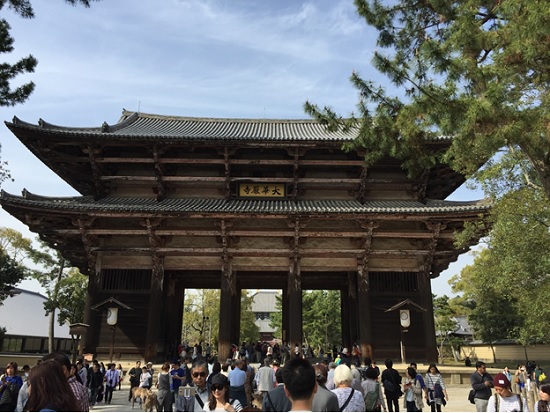
Nandaimon entrance gate of Todaiji Temple
Nara is the nerve center of the cultural heritage of Japan. It is the Mecca of Japan, the city harboring Japan’s gigantic Buddhist statues and unique parks. What’s important about those 74 years, however, is that they witnessed the birth of Japan’s arts, crafts, and literature, as Nara imported everything from religion to art and architecture from China. Even the city itself, laid out in a rectangular grid pattern, was modeled after Chinese concepts. It was during the Nara Period that Japan’s first historical account, first mythological chronicle, and first poetry anthology (with 4,173 poems) were written. Buddhism also flourished, and Nara grew as the political and cultural center of the land with numerous temples, shrines, pagodas, and palaces.
Japanese flock to Nara because it gives them the feeling that they’re communing with ancestors. Foreigners come here because Nara offers them a glimpse of a Japan that was. Remarkably enough, many of Nara’s historic buildings and temples remain intact, and long ago someone had enough foresight to enclose many of these historical structures in the quiet and peaceful confines of a large and spacious Nara park, which has the added attraction of free-roaming deer.
Todaiji Temple
Cultural Importance: UNESCO World Heritage Site
This temple is the most renowned destination in Nara as it harbors the Great Buddha (Daibutsu), Japan’s second-largest bronze Buddha. When Emperor Shomu, considered as the greatest proponent of Buddhism in Japan ( reminds me of King Ashoka) , commanded the construction of both the temple and Daibutsu in the mid-700s, he envisioned to make Todaiji the headquarters of all Buddhist temples in the land. As part of his plans for a Buddhist utopia, he commissioned work for this huge bronze statue of Buddha; it took eight castings to complete this extraordinary work of art. At a height of more than 15m (50 ft.), the Daibutsu is made of 437 tons of bronze, 286 pounds of pure gold, 165 pounds of mercury, and 7 tons of vegetable wax. However, consequent to Japan’s frequent natural calamities, the Buddha of today isn’t quite what it used to be. In 855, in what must have been a whopper of an earthquake, the statue lost its head. It was repaired in 861, but alas, the huge wooden building housing the Buddha was scorched twice during wars, melting the Buddha’s head. The present head dates from 1692.
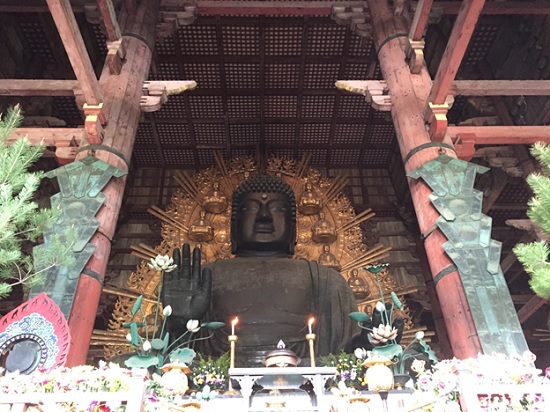
Daibutsu in Todaiji Temple
Todaiji's main hall, the Daibutsuden (Big Buddha Hall) is the world's largest wooden building, despite the fact that the present reconstruction of 1692 is only two thirds of the original temple hall's size. There is a huge wooden column with a small hole in it near the ground. According to popular belief, if you can manage to crawl through this opening, you’ll be sure to reach enlightenment (I could see many children and some lean girls crawling out of it with glee).
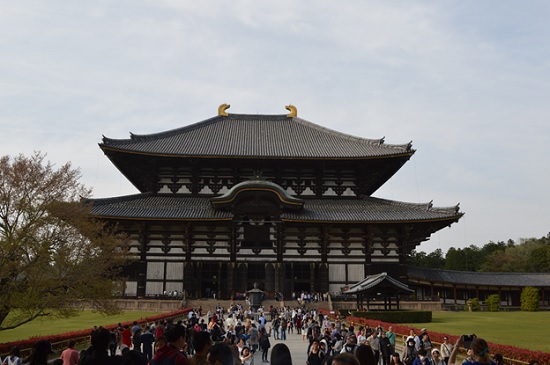
The main hall of Todaiji Temple
As we approach the Todaiji temple, one cannot miss the awe-inspiring Nandaimon Gate, a large wooden gate watched over by two fierce looking statues. Representing the Nio Guardian Kings, the statues are designated national treasures together with the gate itself. I was surprised to see so many graceful deers from the adjacent Nara Park freely mingling with tourists and eating ‘deer cookies’ from them.
Todaji Museum, located near the Nandaimon entrance gate, houses Arts and National Treasures from Todaji and shouldn’t be missed if you visit the temple.
Horyuji Temple
Cultural Importance: UNESCO World Heritage Site, the first to be recognized in Japan in 1993
If you visit Nara, you mustn’t miss this great temple, a jewel of Japan. This temple located in the Kansai region can be reached by a 20 mts short trip by train from Nara JR station. Established in 607 by Prince Shotoku as a center for Buddhism in Japan, Horyuji is one of the cornerstones of historic architecture, art, and religion of Japan. It was from here that Buddhism blossomed and spread throughout the land. This complex contains about 45 buildings, some of them dating from the end of the 7th century, including what is considered as the oldest wooden structure in the world. The whole ambience around this temple complex is engrossing—serene, ancient, and a fitting tribute to revered Prince Shotoku, founder of Buddhism in Japan.
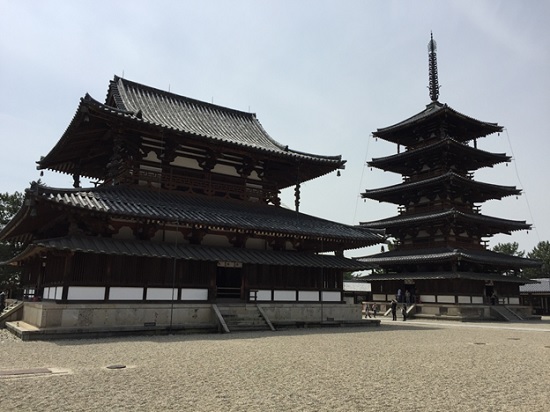
Kondo hall and Pagoda in Horyuji temple
At the western end of the grounds is the two-story, 17m-high Kondo, or main hall, which is considered the oldest building at Horyuji Temple, erected sometime between the 6th and 8th centuries. It contains Buddhas commemorating Prince Shotoku’s parents, protected by Japan’s oldest set of four heavenly guardians (from the late 7th or early 8th century). Next to the main hall is Japan’s oldest five-story pagoda, dating from the foundation of the temple and considered the most important structure of Buddhist temples, as it is here that relics of the Buddha are enshrined; it contains four scenes from the life of Buddha.
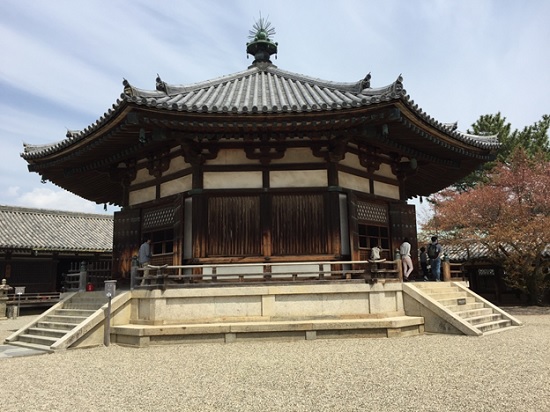
Octagonal Yumedono Hall
The Gallery of Temple Treasures, constructed in 1998, a visual treat to art connoisseurs, contains statues, tabernacles, and other works of art from the 7th and 8th centuries, many of them National Treasures. No photography is allowed here. On the eastern precincts of Horyuji Temple is an octagonal building called Yumedono Hall, or the Hall of Visions, built in 739 as a sanctuary to pray for the repose of Prince Shotoku.
Yakushiji Temple
Cultural Importance: UNESCO World Heritage Site
Yakushiji is one of the seven large temples in Nara (the others being Todaiji, Dainanji, Saidaiji Gangoji, Horyuji and Kofukuji) and is the head temple of the Hosso Sect, the oldest Buddhist sect in Japan. It houses some of the most beautiful Buddhist statues in all of Japan.
Its history dates back to late 7th century (A.D.680) when the erection of Yakushiji was planned by Emperor Temmu to pray for the recovery of his Empress from a serious illness. The construction of Yakushiji on the site of Asuka, the south part of Nara, in the Fujiwara Capital, was not completed before the Emperor’s death.
During the long term of the construction, Temmu died, and his Empress acceded to the throne and was called Jito. In fact the actual construction was taken under her reign, and the dedication ceremony for enshrining the chief Buddha, Yakushi Nyorai, was held in 697.The whole compound was completed in 698. But it was only ten years later that the Capital was moved to the north of Nara (in 710), and Yakushiji was also moved to the present site in 718.
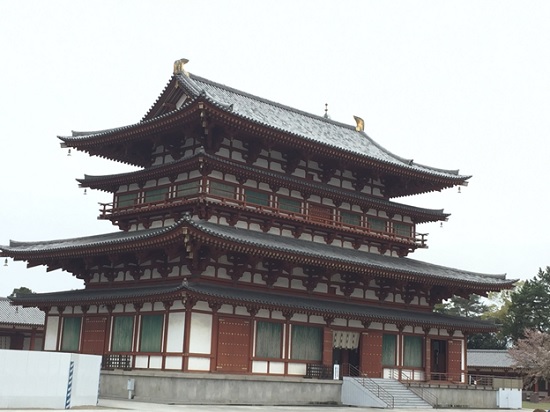
Kondo main hall
The splendid layout of buildings including Kondo (Main Hall), Kodo (Lecture Hall), the East and West Pagoda are a visual treat. The Kondo hall, rebuilt in 1976, contain several images, including the famous Yakushi Triad (Healing Buddha flanked by the Bodhisattvas of sun and moon). Behind Kondo is the Kodo (Lecture hall), which again house another fine Buddhist trinity. Unfortunately, no photography is allowed here.
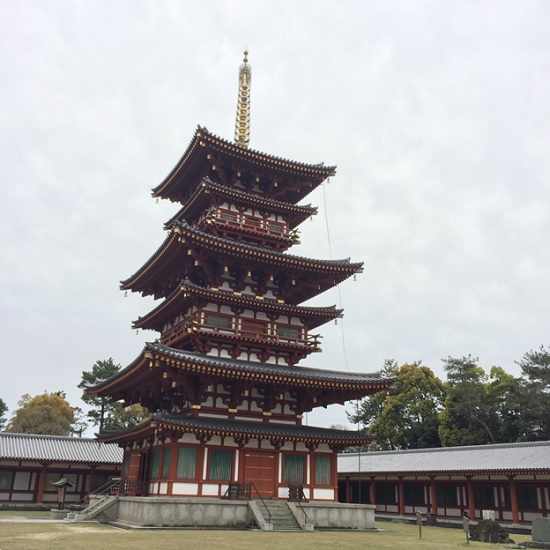
East Pagoda
However, Yakushiji was burnt down and destroyed by fires, wars, or natural disasters several times, and the largest damage was caused by the civil war in 1528. Today only the Yakushiji Triad in the Kondo, the Sho-Kannon in the Toindo, and the East Pagoda, known as “frozen music”, recall the grandeur of its original features.
|
Toshodai-ji Temple
Cultural Importance: UNESCO World Heritage Site
This temple, as said earlier, is a 500m walk north of Yakushi-ji's northern gate. The Toshodaiji Temple is one of the oldest structures in Nara, built in 759 by the Chinese priest Ganjin (Jian Zhen), who had been recruited by Emperor Sh?mu to reform Buddhism in Japan. The temple grounds are pleasantly wooded and mossy, making a good contrast to nearby Yakushi-ji, which is largely devoid of greenery. The moss garden here under Japanese Cypress and Maple trees is a captivating attraction.
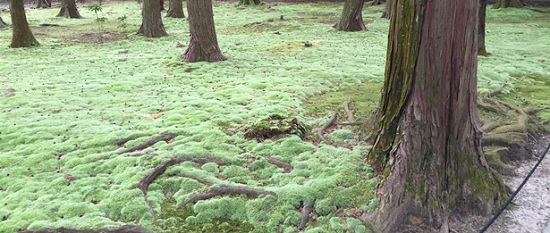
Moss Garden in Toshodaiji temple
The Kondo (Golden Hall), roughly in the middle, contains a stunning Senju (thousand-armed) Kannon image. Behind it, the Kodo (Lecture Hall), contains a beautiful image of Miroku Buddha.
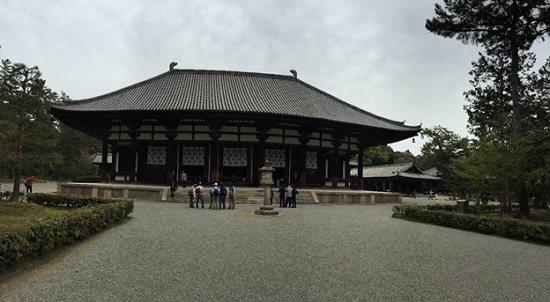
Golden Hall in Toshodaiji temple
Its buildings, in contrast to the bright colors of Yakushi-ji, have been allowed to age, but you can still see remnants of the colors on the back of the hall.
Kofukuji Temple
Cultural Importance: UNESCO World Heritage Site
This temple belonged to the famed Fujiwara family which held great influence during the Nara and Heian Periods. The temple was established in Nara at the same time as the capital in 710. In the past, it was said that the temple had 150 structures. Now, only a few buildings remain and among them is the five-storied pagoda which is known as the second tallest “old tower” in Japan. Kofukuji's pagoda is both a landmark and symbol of Nara. It was first built in 730, and was most recently rebuilt in 1426.
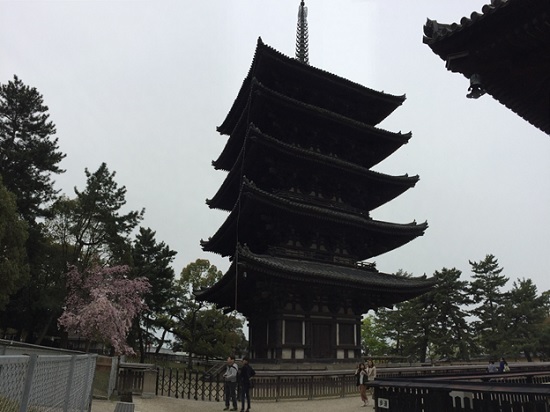
Five-storied pagoda in Kofukuji temple
Kofukuji's National Treasure Museum exhibits part of the temple's great art collection and is an absolute must-see for lovers of Buddhist art. Among the many outstanding exhibits is the three-faced, six-armed Ashura Statue, one of the most celebrated Buddhist statues in all of Japan.
Koyasan
The Japanese medieval epic Heike Monogatari relates that when retired Emperor Shirakawa (1053–1129) expressed a desire to embark on the ultimate religious pilgrimage—that is, to travel to distant India, the land where the historical Buddha had preached—adviser and scholar Oe Masafusa suggested a less hazardous but equally exalted destination. “You may find an incarnation of the Great Sun Buddha on Mount Koya here in our own country,” Masafusa declared. “Shakyamuni in India and Kobo Daishi in Japan both attained Buddhahood while still alive. Kobo Daishi’s virtue gave light to the darkness that had long ruled the world. Even after his death he continues to sustain his flesh on Mount Koya in wait for the appearance of Maitreya Bodhisattva, the Buddha of the Future.
Mount Koya—called Koyasan by Japanese—is one of Japan’s most sacred places and the mecca of the Shingon Esoteric sect of Buddhism. For more than one thousand years, the vast Buddhist monastery and temple complex on remote Mount Koya has been one of Japan's most important religious centers. Saint Kobo Daishi (also known as Kukai), founder of the esoteric Shingon school and one of the great figures of world Buddhism, consecrated the mountain for holy purposes in the early 800s. Standing almost 900m (3,000 ft.) above the world, the top of Mount Koya is home to more than 115 Shingon Buddhist temples scattered through the mountain forests.
A World Heritage Site, Koyasan first became a place of meditation and religious learning almost 1,200 years ago when Kukai, known posthumously as Kobo Daishi, was granted the mountaintop by the imperial court in 816 as a place to establish his Shingon sect of Buddhism. Kobo Daishi was a charismatic priest who had spent 2 years in China studying esoteric Buddhism before returning to his native land to spread his teachings among Japanese. Revered for his excellent calligraphy, his humanitarianism, and his teachings, Kobo Daishi remains one of the most beloved figures in Japanese Buddhist history. When he died in the 9th century, he was laid to rest in a mausoleum on Mount Koya. Kobo Daishi, his followers believe, is said to be still alive, selflessly advocating for the salvation of all sentient beings and awaiting the arrival of the last bodhisattva (Buddha messiah). According to popular belief, priests opening his mausoleum decades after his death found his body still warm.
Okunoin
Cultural Importance: UNESCO World Heritage Site
The most breathtaking and magnificent of Koyasan’s many structures and temples is Okunoin as it contains the mausoleum of Kobo Daishi. The best way to visit the mausoleum is by taking a 2.0 KM walk from the Okunoin-guchi bus which is the stop where my temple stay was also located.
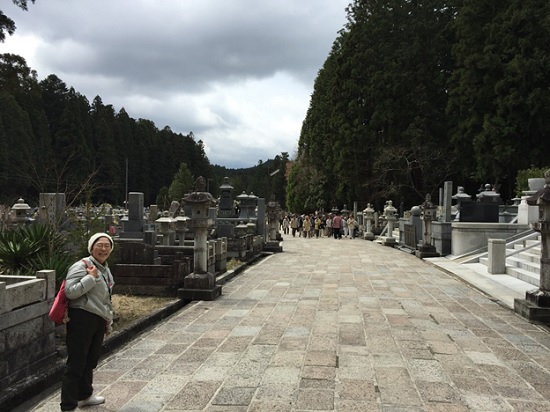
Different tomb stones along the pathway
The Ichinohashi Bridge (first bridge) marks the traditional entrance to Okunoin, and visitors should bow to pay respect to Kobo Daishi before crossing it. Across the bridge starts Okunoin's cemetery, the largest in Japan, with over 200,000 tombstones all along the path leading to Kobo Daishi's mausoleum. Wishing to be close to Kobo Daishi in death to receive salvation, many people, including prominent monks and feudal lords, have had their tombstones erected here over the centuries. Interestingly, many corporates have also built fascinating tombstones. The styles of the burial memorials vary too much for the eye to dwell on each of them, but the most spectacular cenotaphs attract attention, such as the one an insecticide company dedicated to its termite victims.
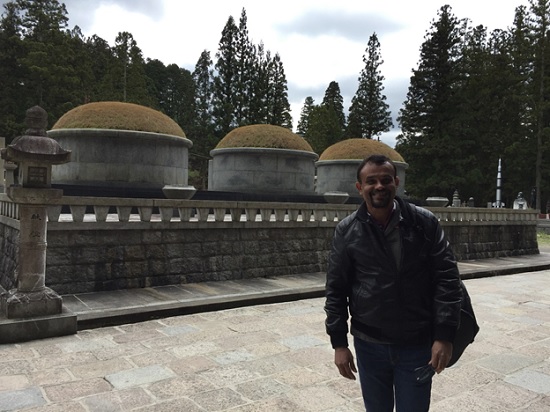
Tomb for termites
The whole pathway is swathed in a reverential darkness of huge cypress trees forming a canopy overhead and all along you see monument after monument, stone lantern after stone lantern, tomb after tomb, I must confess that I have never visited a place like this where I can draw comparison in terms of the sheer immensity of its experience. The unending array of tombs-small and big, children and elders, common people and Feudal Lords-and the tall cypresses and its gnarled branches, the shimmering moss in the pathway, shafts of sunlight slyly seeping through the trees are a spectacle that can overwhelm anyone.
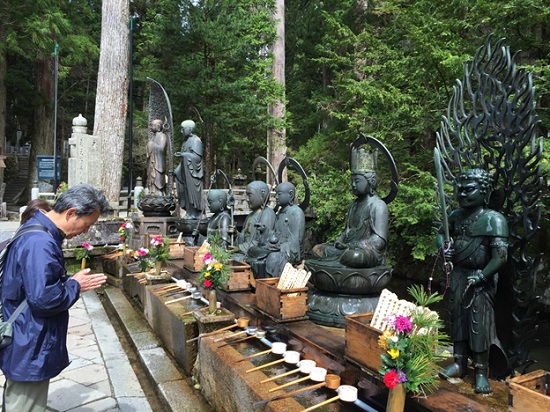
A prayer station before proceeding to Kobo Daishi's mausoleum
At the culmination of the pathway, about a 30-minute walk away, is the Lantern Hall, or Torodo, which houses about 21,000 lanterns, donated by prime ministers, emperors, and others. Two sacred fires, which reportedly have been burning since the 11th century, are kept safely inside. The mausoleum itself is behind the Lantern Hall. In the hall's basement are 50,000 tiny statues that have been donated to Okunoin on the occasion of the 1150th anniversary of Kobo Daishi's entrance into eternal meditation in 1984.
Kongobu-ji Temple
Cultural Importance: UNESCO World Heritage Site
Kongobu-ji serves as the administrative and spiritual headquarters for more than three thousand affiliated Koyasan Shingon temples spread around the nation and overseas. Above all, the mountain continues to be a venue of divine Wisdom and Compassion, symbolized by Saint Kobo Daishi seated in his tomb and the golden Great Sun Buddha seated in the Great Stupa.
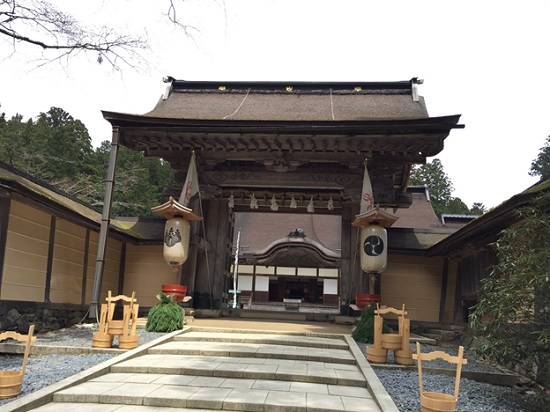
Entrance to Kongobuji temple
Although Kongobuji was originally built in the 16th century by Toyotomi Hideyoshi to commemorate his mother’s death, the present structure dates from the 19th century. The main hall's Ohiro-ma room has ornate screens painted by Kano Tanyu in the 16th century. Pictures by famous artists from long ago decorate the sliding doors of the inner rooms, including those depicting Kobo Daishi’s trip to China.
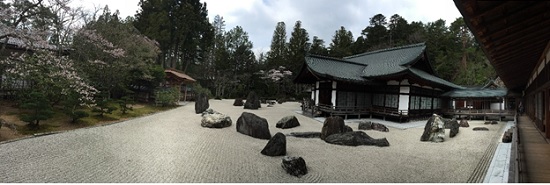
Rock garden
The most important thing to see, however, is the temple’s magnificent rock garden, reputedly the largest in Japan and said to represent a pair of dragons in a sea of clouds. The rock garden is interesting for the sheer number of rocks used in its composition, giving the effect of a throng of petrified worshippers eagerly listening to a monk's sermon.
Garan Temple Complex
Cultural Importance: UNESCO World Heritage Site
Garan complex contains the first buildings constructed on Koyasan and is still considered the center of religious life in the community living in Koyasan. Legend has it that Kobo Daishi, the founder of Shingon Buddhism, threw his sankosho (a double ended, three pronged Vajra , a Buddhist ceremonial tool) from China, where he had been studying, toward Japan. Back in Japan, while in search of a place to headquarter his new religion, he came across his sankosho stuck in the branches of a pine tree on Koyasan and started construction of the Garan, Koyasan's central temple complex. The pine tree, that caught the sankosho, is still growing there.
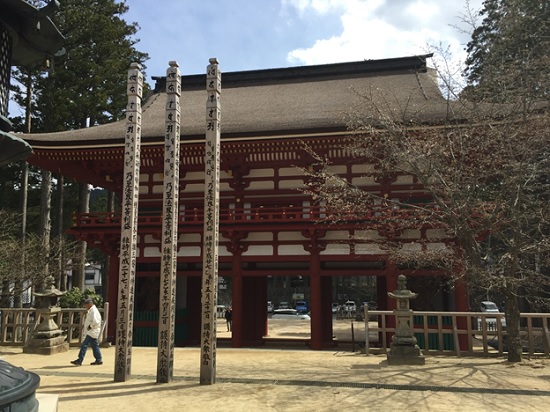
Chumon Middle gate in Garan Complex
The two most prominent buildings of the Garan are the Kondo Hall and the huge vermillion colored Konpon Daito Pagoda. The Kondo Hall is a large wooden temple hall where major ceremonies are held. The building has burned down multiple times over the centuries, and the current hall dates back to 1932. It enshrines an image of Yakushi Nyorai, the Buddha of medicine and healing.
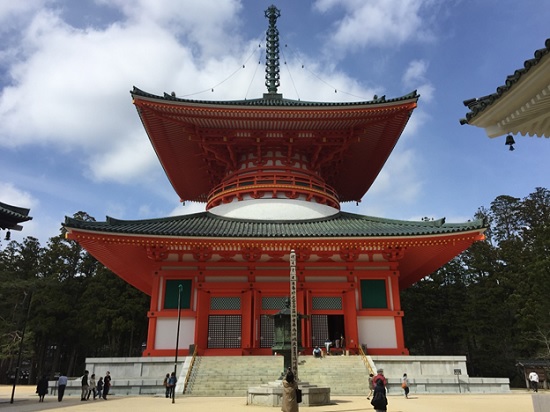
Konpon Daito Pagoda
Next to the Kondo Hall stands the vermilion Konpon Daito Pagoda, a 45 meter tall, two tiered, tahoto style pagoda, which many consider to be Koyasan’s most magnificent structure. A statue of the Dainichi Nyorai (Cosmic Buddha, also known as Variocana), the central Buddha in Shingon Buddhism, stands in the middle of the pagoda's interior and is surrounded by statues and paintings on pillars, which together make up a rare three dimensional mandala (a metaphysical map of the cosmos).
Kobo Daishi started building the Kondo Hall and Daito Pagoda, however he was not able to finish them himself. His successors completed the construction of the two main structures and also expanded the grounds of the Garan with multiple additional halls and pagodas over time. Among these are the Toto (eastern pagoda), Saito (western pagoda), Miedo (founder's hall) and Koya Myojin Shrine, which enshrines Mount Koya's local kami (Shinto deities).
Concluding Remarks
Nara and Koyasan are the best places to visit in Japan if you harbor Buddhist philosophy and love to visit ancient temples that still practice Buddhist rituals. Anyone visiting Nara should plan two days in the city. I had miscalculated it and as a result I had to keep my luggage in a cloak cabin in Nara JR station (Throughout Japan, luckily, most stations offer user-friendly locker facilities) to complete my visit. Koyasan is most conveniently accessed by Nankai Railways from Osaka's Namba or Shin-Imamiya Stations. Take the Nankai Koya Line from either station to the Gokurakubashi terminal station. At Gokurakubashi, transfer to the cable car which travels up the mountain to Koyasan. The ride takes about five minutes and costs 390 yen. From the top station, it is a ten minute bus ride into the different temple Lodgings.
Remember, there are no hotels in Koyasan. All are superb temple accommodations with separate bath and surprisingly excellent Wi-Fi connection. Koyasan is one of the best places in Japan to experience a night at a temple. Guests are also invited to participate in morning prayers which typically start around 6:00am, last for about 30-45 minutes and are followed by Zen Vegetarian breakfast.
Continued to “Kanazawa, Himeji and Hiroshima: Beauty and Sadness”
29-May-2016
More by : P. G. R. Nair